Fragments of Childhood – Then and Now
by Jemima Jarman,
Assistant Curator
The Jewish Museum London recently received a generous
donation of 14 charming oil paintings, depicting East Ham, Ilford in the 1930s.
The artist, A. David Crown, M.D., (1924-2016), created these paintings after
retiring from a medical career in Rochester, New York; drawing upon memories of
his early childhood and the neighbourhood he grew up in. Each painting is
accompanied with written memories of the place he depicts.
The subjects of his paintings include street scenes, shop
fronts, cinemas, synagogues and London buses. Each painting is full of warmth
and character in which Crown’s childhood memories are depicted in bright
colours and where each scene bursts with nostalgic detail. Dr. Crown wrote in
his opening statement: “The paintings do not exactly depict the places, nor are
they to scale…but they show what cannot be said. And the accompanying brief
recollections have said what cannot be shown.”
Both the series of paintings and the written memoirs were entrusted
to the Jewish Museum London by Dr. David Crown’s widow, Deborah Cohen-Crown; who
has enabled these stories and images of a Jewish childhood in 1930’s Britain to
be shared with future generations.
Of the 14 oils, 6 have been selected to feature in this blog
post with Crown’s own (edited) text accompanying them.
King’s Dairy
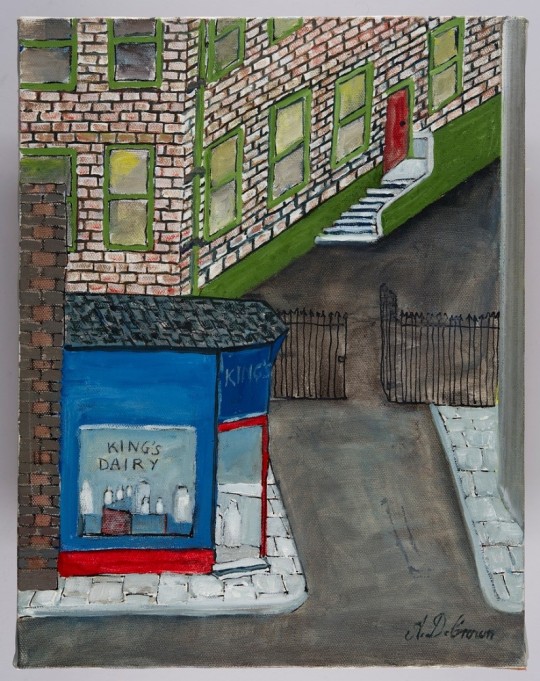
“King’s Dairy was across High
Street North, beside a short road to the Salisbury Elementary School. It was, I
was told, the last actual dairy with cows in Greater London. Indeed, there were
cows behind the store front – I went past them and smelled them every school
day till I was nearly eleven.
Behind it was my school (not that
colour of course). The stairs are where
Ivor Good, Saul Cohen, David Miller, Dennis Morris and I nightly fought Gerald
Cox and his Jew hating friends many many nights when we came out from classes
to go home. Ivor was not Jewish but as we were outnumbered and he adored ideas
of chivalry and was taller than us and a good fighter, he was very welcome.
My memories of that school are
prolific – of Miss Lindsell who encouraged me to write and in whose classroom
at my suggestion we created a lending library which failed dismally – the books
were stolen. She’s the one who, when I
used words like “ichthyology” and “Jewfish” denied they
existed. Also that darned anti-Semitic
Mr. James who caned me and threatened me with his Luger on the last day before
Christmas vacation, when I was ten, because of my response to Dennis William
Davis’s crude note depicting a “wandering Jew.” My drawing was better! So was my reply but
James intercepted it, caned me, and as a result the four Jews in the class were
segregated in the far back corner and told to be silent throughout the
festivities or he would shoot us.”
Fire Engine Fanny
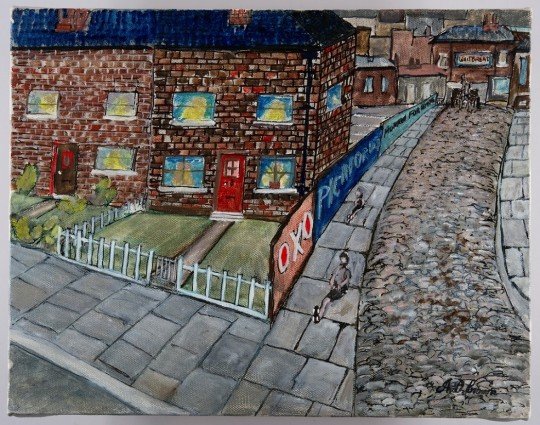
“The bridge over the railway where
the Manor Park Station was located was ideal for roller skating. The game
required that you waddled up the hill like a person wearing skis and then come
whizzing down, turning the corner at the bottom or else you would shoot off the
curb and into the road, possibly into the path of oncoming vehicles –
potentially dangerous. In the painting there are only two of us whereas usually
there were many more, even 5 or 6.
The first house round the corner,
with its hinged gate and gravel path, led to the door of Fire Engine Fanny, so
named for her bright red nose. At night, usually frosty and cold, we would
silently (except for suppressed giggles) unlatch the gate and shuffle with our
skates on to the front door…then we would bang loudly on her door, yell
insults through her letter box and flee.
In the painting the coalman’s dray
horse is coming over the crest with his sacks of coal. But on the way up the
other side the horses would often slip slide and stumble to their knees. Their
steel shoes on the cobbles would throw up comet-like showers of sparks. I was
fascinated when these horses would urinate, a torrent of steaming splashing
yellow pee. And I would watch when they lifted their tails to deposit mounds of
steaming straw-filled poop on the road. The sparrows loved it. I have left some
of it on the road in the picture!”
Cheder
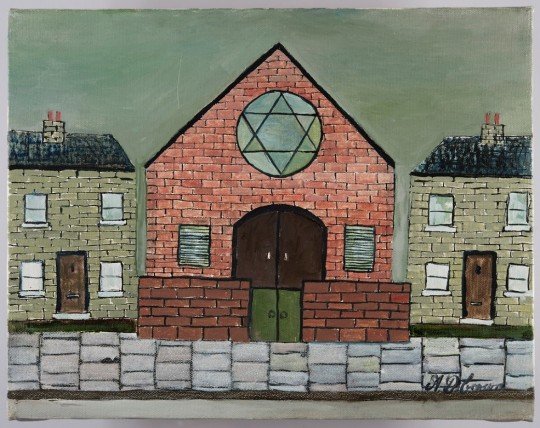
“Carlisle Street was a very
ordinary street, gray with rowhouses on both sides. About two hundred yards
down on the south side was the synagogue. The rabbi, actually a chazen, was Mr.
Miller. The front cement yard was quite small and on religious holidays it was
packed with men taking a breather. It was enclosed by 6 foot walls except for
the entrance. Then came the huge double wooden doors and once inside it was
suddenly dark till ones eyes adjusted.
There was a room off to the side
with rows of desks for our cheder. The teacher, a short man with an agitated
shiny bald head and a few strands of greasy hair, mustard-coloured stains down
his front and smelling of stale sweat and pickled herring, would stride up and
down the aisles very excited. He carried a black ruler and if he came up behind
you and found you were inattentive (like having your book open at the wrong
page) he would crack you across your knuckles with that ruler. I did not like
him. I did not like being pent in. I played truant, cricket or soccer or street
games being preferable. I missed class as often as I could but I had to attend
one day each month. That was the day dad gave me 2/6 to pay for my lessons. I
knew that if I did not show up that day with the money, questions would be
asked, and the truth would come out.
The last time I saw
the synagogue a few years ago, it was disused, locked up, derelict with barbed
wire along the walls.”
Barber’s Bakery
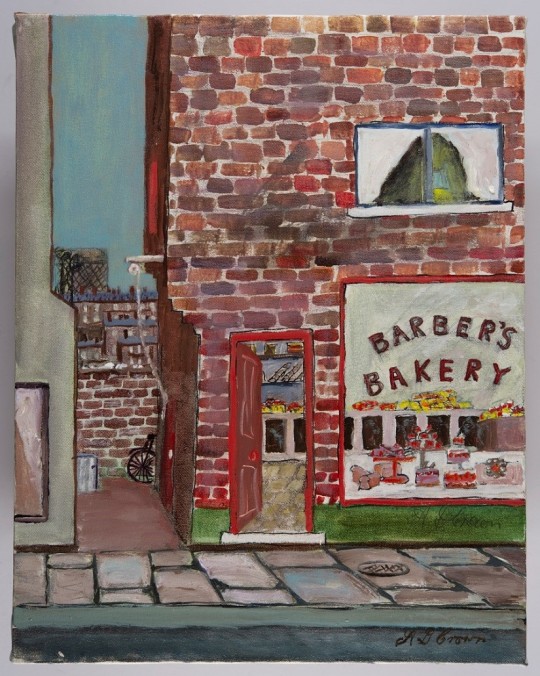
“The bakery was a family run affair
– rather “low life” types. The
toy miniature loaves of Hovis, 1d (1 penny each) were my favourite. I would
have it all to myself. I spent a lot of time in the back room where the ovens
were, swatting numerous flies for Mr. Barber.
But I stopped helping him this way when I encountered a corpse in my
slice of raisin bread!
The bakery was very 2nd rate, 3rd,
4th even. Behind the shop the family of
6 or 7 lived and they bought their potatoes by the sack – I’d never seen that
before or for that matter, since. One
Christmas when we had all of our family and friends for dinner, dad bought a
30+lb turkey which wouldn’t fit our oven but he arranged with Mr. Barber to
cook it in his bread oven- along with some neighbour’s turkeys. I went with
him on that cold day, to carry it home on a wooden board from the bakery…very
slowly along the slippery alley and home by the back gate.”
Spare a Copper
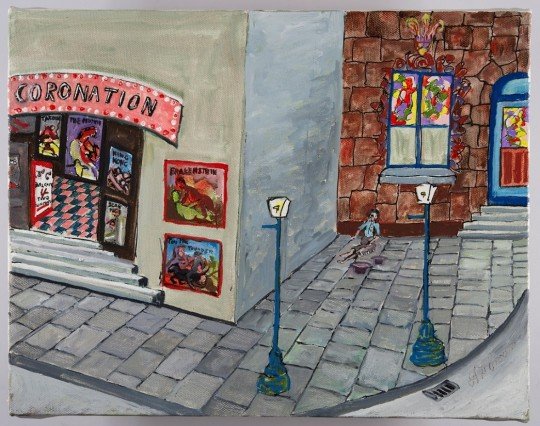
“I go to the movies almost every
Saturday afternoon. The Coronation Cinema was probably opened at the beginning
of the reign of George V and Mary. For 3
pence you saw two features, assorted shorts (Pathe Gazette, a couple of gay
fellows in tennis togs or evening dress, one playing the piano while the other
leans languorously against it and sings daft stuff, and several animated
cartoons). And there’s an interval when the lights come on for a while and the
theatre organ mysteriously rises from profound depths for a recital. All
organists seem to be named Reginald. All for three pence. Of course, when the
lights are down and the scant audience’s cigarette smoke curls up through the
flickering beams of the movie, I sneak down to the front sixpenny seats. I
might stay on to see the movie, or part of it twice, moving to a different seat
believing the usher won’t catch me- he doesn’t care. The biggest
problem was getting into the theatre because sometimes the film was Adult
rated. Kids not allowed in except accompanied by an adult. So you hung around
the entrance and kept running up to people who were going in and asked them to
take you in with them. It never failed. “I’ve got me thruppence mister…will
you take me in?” “The last time I saw the Coronation it was a bingo hall.”
Eels
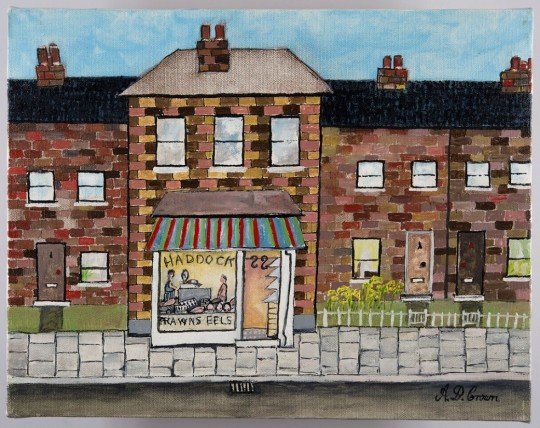
“The fishmonger was about 8 houses
north of 484. The shop was an add-on in front of a rather singular row house.
The proprietor was a very friendly man and I would go into his shop and ask him
for some oil-paper which was a heavy tracing paper. The fish was wrapped in
this and then the package was wrapped in newspaper. I wanted the tracing paper
to trace magazine pictures which I would subsequently show to my mother, “Chops”,
and claim they were original drawings. No one was fooled. But I developed many
variations such as placing the drawing face down on a white piece of paper and
rubbing the back to create a reverse image. And I discovered how to enlarge
pictures to scale, portraits too, by drawing a grid and transferring it another
piece of paper larger than the original. I loved to draw and water colour. When
I stated I wanted to grow up to be an artist Leon (my brother) told me it was
forbidden for Jews to make a graven image, especially a Cohen. Till my
mid-teens I believed there were no Jewish artists! ”